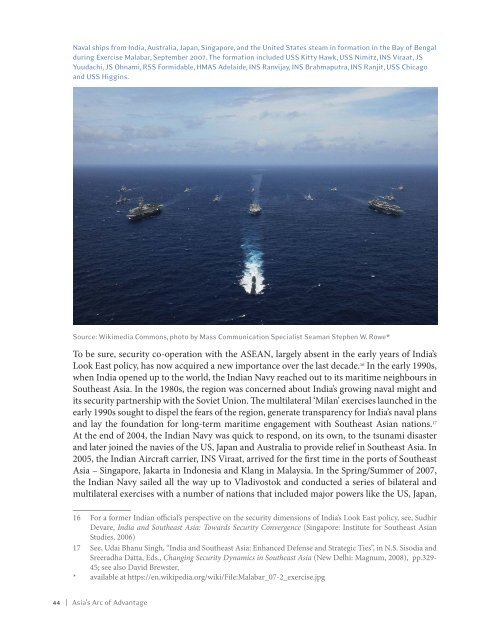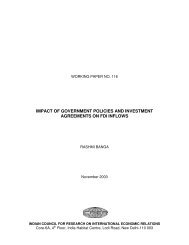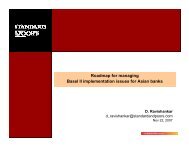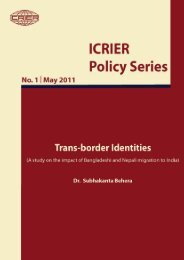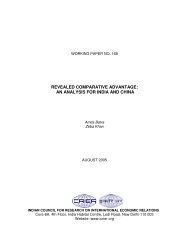Asia's Arc of Advantage - icrier
Asia's Arc of Advantage - icrier
Asia's Arc of Advantage - icrier
Create successful ePaper yourself
Turn your PDF publications into a flip-book with our unique Google optimized e-Paper software.
Naval ships from India, Australia, Japan, Singapore, and the United States steam in formation in the Bay <strong>of</strong> Bengal<br />
during Exercise Malabar, September 2007. The formation included USS Kitty Hawk, USS Nimitz, INS Viraat, JS<br />
Yuudachi, JS Ohnami, RSS Formidable, HMAS Adelaide, INS Ranvijay, INS Brahmaputra, INS Ranjit, USS Chicago<br />
and USS Higgins.<br />
Source: Wikimedia Commons, photo by Mass Communication Specialist Seaman Stephen W. Rowe*<br />
To be sure, security co-operation with the ASEAN, largely absent in the early years <strong>of</strong> India’s<br />
Look East policy, has now acquired a new importance over the last decade. 16 In the early 1990s,<br />
when India opened up to the world, the Indian Navy reached out to its maritime neighbours in<br />
Southeast Asia. In the 1980s, the region was concerned about India’s growing naval might and<br />
its security partnership with the Soviet Union. The multilateral ‘Milan’ exercises launched in the<br />
early 1990s sought to dispel the fears <strong>of</strong> the region, generate transparency for India’s naval plans<br />
and lay the foundation for long-term maritime engagement with Southeast Asian nations. 17<br />
At the end <strong>of</strong> 2004, the Indian Navy was quick to respond, on its own, to the tsunami disaster<br />
and later joined the navies <strong>of</strong> the US, Japan and Australia to provide relief in Southeast Asia. In<br />
2005, the Indian Aircraft carrier, INS Viraat, arrived for the first time in the ports <strong>of</strong> Southeast<br />
Asia – Singapore, Jakarta in Indonesia and Klang in Malaysia. In the Spring/Summer <strong>of</strong> 2007,<br />
the Indian Navy sailed all the way up to Vladivostok and conducted a series <strong>of</strong> bilateral and<br />
multilateral exercises with a number <strong>of</strong> nations that included major powers like the US, Japan,<br />
16 For a former Indian <strong>of</strong>ficial’s perspective on the security dimensions <strong>of</strong> India’s Look East policy, see, Sudhir<br />
Devare, India and Southeast Asia: Towards Security Convergence (Singapore: Institute for Southeast Asian<br />
Studies, 2006)<br />
17 See, Udai Bhanu Singh, “India and Southeast Asia: Enhanced Defense and Strategic Ties”, in N.S. Sisodia and<br />
Sreeradha Datta, Eds., Changing Security Dynamics in Southeast Asia (New Delhi: Magnum, 2008), pp.329-<br />
45; see also David Brewster,<br />
* available at https://en.wikipedia.org/wiki/File:Malabar_07-2_exercise.jpg<br />
44 | Asia’s <strong>Arc</strong> <strong>of</strong> <strong>Advantage</strong>


